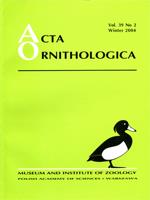An abundant resident in Israel, the Graceful Warbler breeds in the northern and central parts of the country and has recently invaded desert areas following their human settlement. Possible seasonal changes in age and sex structure were investigated, as were differences in body measurements in individual sex and age classes as well as changes in the numbers of the Graceful Warbler population in Eilat. No difference was recorded between spring and autumn in the proportion of males to females, nor were significant differences found in the numbers of males and females ringed during the spring and autumn seasons. There was a significant difference in the proportion of juvenile to adult birds trapped in spring and in autumn. Moreover, males had longer wings than females in both seasons. There were no differences in body mass or body condition between sexes in the two seasons. Furthermore, adults had longer wings than first-year birds. Juveniles had longer wings in autumn than in spring, but no differences were recorded in the adults in this respect. In addition, juveniles were in better condition in spring than in autumn; however, there was no difference in body condition of the adults between seasons. The fact that a significant trend was found in the numbers of Graceful Warblers trapped in spring but no such trend in autumn, that a large proportion of recaptured birds were noted in both seasons, and that a high number of individual birds were caught repeatedly during the study period, suggests the existence of a stable or increasing breeding population in Eilat all the year round. In addition, the Bird Sanctuary is like an oasis in the desert environs of Eilat. Hence, the lack of differences among the years in the proportions of males and females between the seasons suggests that it is mainly breeding pairs that occupy the area.
How to translate text using browser tools
1 December 2004
Seasonal Biometric Differences Between Sex and Age Groups of the Graceful Warbler Prinia gracilis at Eilat (Israel)
Piotr Zduniak,
Reuven Yosef
S. Cramp
1998. The Complete Birds of Western Palearctic on CD-ROM. Oxford Univ. Press. Google Scholar
T. I. Fuisz
,
R. Yosef
2001. Effect of habitat quality on the hunting behaviour of breeding Great Grey Shrikes (Lanius excubitor). Acta Zool. Acad. Sci. Hung. 47: 311–320. Google Scholar
J. Moreno
1989. Strategies of mass change in breeding birds. Biol. J. Linnean Soc. 39: 297–310. Google Scholar
U. Paz
1978. [Population dynamics of Graceful Warbler (Prinia gracilis palaestina Zedliz) and the significance of clutch size in song birds (Passeriformes)]. PhD Thesis, Tel Aviv Univ. Google Scholar
D. W. Snow
,
C. M. Perrins
1998. The birds of the Western Palearctic, concise edition. Oxford Univ. Press. Google Scholar
L. Svensson
1992. Identification guide to European passerines. 4th ed. Naturhistoriska Riksmuseet, Stockholm. Google Scholar
R. Yosef
1997. On habitat-specific nutritional condition in Graceful Warblers Prinia gracilis: evidence from ptilochronology. J. Ornithol. 138: 309–313. Google Scholar
R. Yosef
,
L. Fornasari
,
P. Tryjanowski
,
M. J. Bechard
,
G S. Kaltenecker
2003. Differential spring migration of adult and juvenile Levant Sparrowhawk (Accipiter brevipes) through Eilat, Israel. J. Raptor Res. 37: 31–36. Google Scholar

Acta Ornithologica
Vol. 39 • No. 2
December 2004
Vol. 39 • No. 2
December 2004
biometric
Eilat
Graceful Warbler
Prinia gracilis




